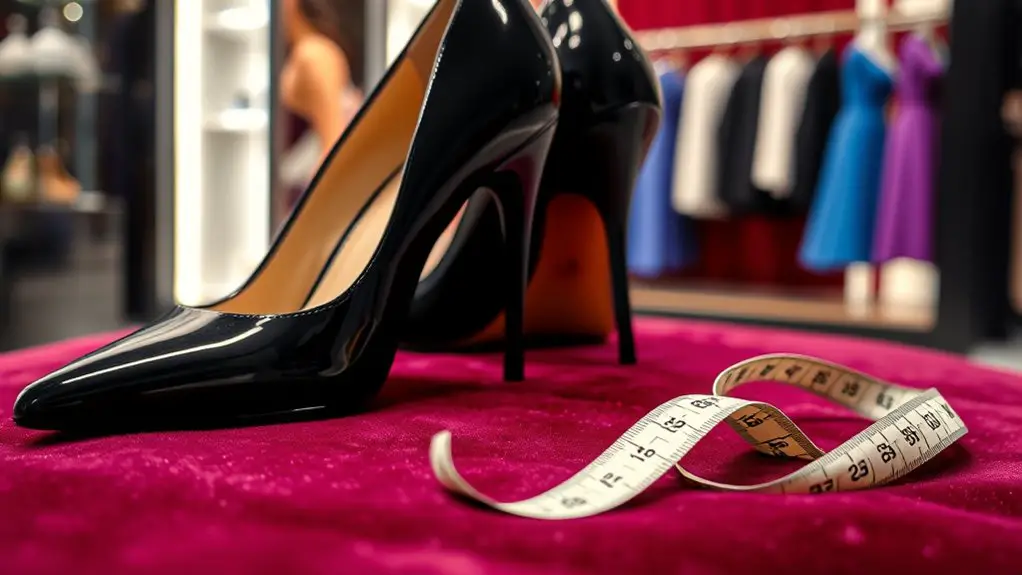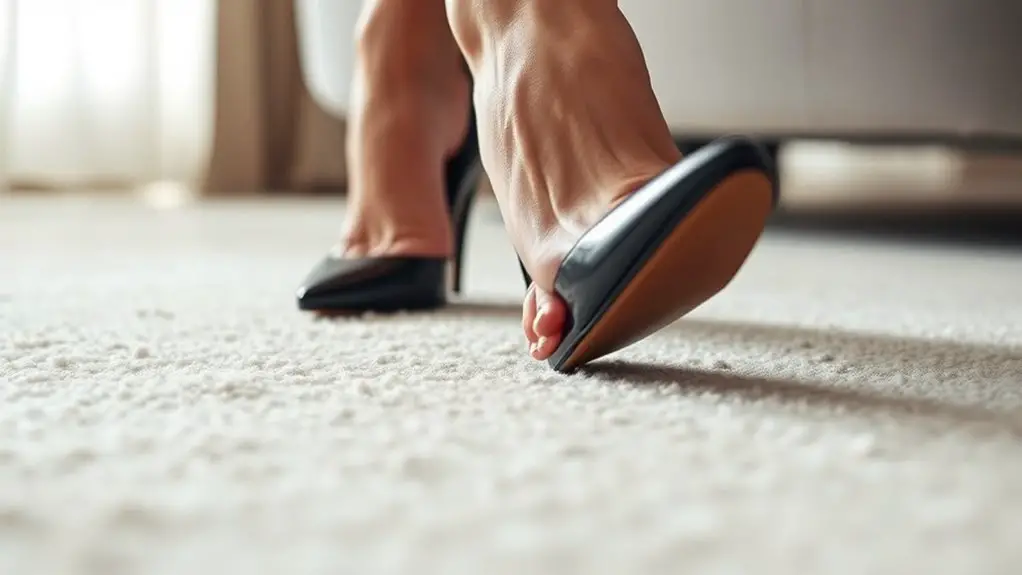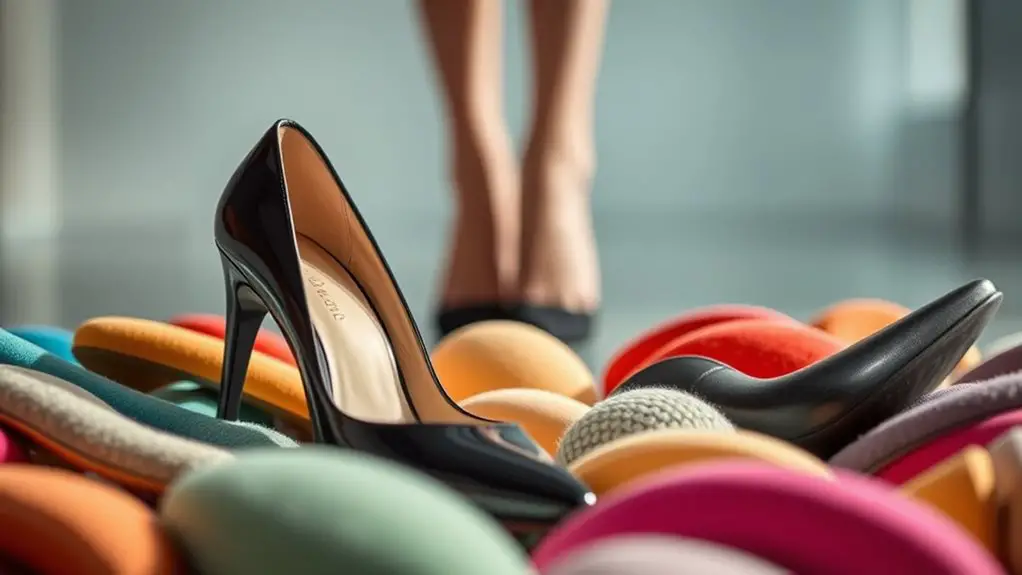To avoid bunions when wearing high heels, start by choosing the right size and fit; guarantee there’s a half-inch space between your longest toe and the shoe’s end. Opt for styles with a wider toe box and invest in quality materials that flex. Limit your wear time and consider using cushioned inserts for additional support. Regularly assess your shoe fit, and you’ll find more strategies to keep your feet healthy and comfortable in high heels.
Choose the Right Size and Fit

Choosing the right size and fit for your high heels is essential in preventing bunions. Proper shoe fitting techniques can greatly reduce the risk of developing foot issues. Start by measuring your feet at the end of the day when they’re most swollen; this guarantees a more accurate size. Don’t just rely on your usual size, as different brands can vary.
When trying on heels, make certain there’s about a half-inch space between your longest toe and the shoe’s end. This extra room accommodates foot movement and minimizes pressure on your toes.
Additionally, avoid styles that pinch or squeeze your feet. Remember, comfort is key. Use bunion prevention tips like wearing your new heels for short periods before committing to longer wear. By prioritizing the right size and fit, you’ll not only feel better but also protect your feet from future complications.
Opt for a Wider Toe Box
A wider toe box can make all the difference in your high heel experience, especially when it comes to preventing bunions. Choosing shoes with a wider toe box provides significant toe box benefits, allowing your toes to spread comfortably rather than being cramped together. This extra space decreases pressure on the joints and ligaments, which can help prevent the formation of bunions.
When shopping for high heels, pay attention to shoe width as well as size. Many brands now offer different width options, so you can find a perfect fit that accommodates your foot shape. Remember, your toes shouldn’t feel squished; instead, they should sit naturally within the shoe.
Limit Wear Time

Even with the right fit and a wider toe box, overdoing it in high heels can still lead to issues like bunions. To prevent this, it’s essential to practice effective time management when deciding how long to wear your heels. Limit the duration of your high heel wear to special occasions or shorter outings. This helps your feet avoid prolonged pressure and strain, reducing the risk of bunion development.
Consider heel alternatives for everyday use, such as stylish flats or low-heeled shoes. These options can provide comfort without compromising your style. If you must wear heels for an extended period, take breaks whenever possible to relieve pressure on your feet. By balancing your high heel usage with more foot-friendly footwear, you can enjoy your favorite styles while minimizing the risk of bunions. Remember, moderation is key to maintaining healthy feet.
Invest in Quality Footwear
Investing in quality footwear is essential for maintaining foot health, especially if you wear high heels regularly. You’ll want to choose shoes that fit properly, offer supportive designs, and are made from high-quality materials. These factors can greatly reduce your risk of developing bunions and other foot-related issues.
Choose Proper Fit
Finding the right fit in footwear is essential for preventing bunions, especially when it comes to high heels. You should always prioritize your foot health by choosing shoes that accommodate your foot shape without squeezing the toes. Look for high-quality shoe materials that provide flexibility and breathability, as rigid options can exacerbate discomfort. Make sure there’s enough room to move your toes, and avoid styles with a narrow toe box. Proper fit not only enhances comfort but also reduces pressure on the joints, which is vital when wearing heels. Remember, investing in well-fitting shoes will pay off in the long run by keeping your feet healthy and minimizing the risk of developing bunions.
Select Supportive Design
A well-designed shoe can make all the difference in preventing bunions, especially when you’re drawn to high heels. When selecting footwear, look for specific design features that promote comfort and support. A moderate heel height, ideally between 1.5 to 2 inches, helps maintain foot stability while reducing pressure on the toes. Additionally, shoes with a rounded toe box allow your toes to move freely, minimizing the risk of bunion formation.
| Design Feature | Description | Benefits |
|---|---|---|
| Heel Height | Moderate (1.5 to 2 inches) | Reduces pressure on toes |
| Toe Box Shape | Rounded | Provides room for toe movement |
| Arch Support | Contoured support | Enhances overall foot stability |
| Cushioning | Ample padding | Absorbs shock and increases comfort |
Prioritize Quality Materials
Choosing high-quality materials is just as important as selecting the right design features for your footwear. When it comes to bunion prevention, the material quality of your high heels plays a vital role. Opt for shoes made from soft, breathable materials like leather or suede, which can adapt to your foot shape without causing excessive pressure. Avoid synthetic materials that may not provide adequate support or flexibility. Well-constructed footwear with quality linings and cushioning can greatly reduce friction and discomfort, decreasing the likelihood of developing bunions. Investing in high-quality shoes not only enhances comfort but also prolongs the lifespan of your footwear, making it a smart choice for both your feet and your wardrobe. Prioritize material quality for a healthier, more stylish step.
Use Cushioned Inserts
Using cushioned inserts in your high heels can greatly enhance comfort and support throughout the day. These inserts help distribute pressure more evenly across your feet, reducing the risk of developing painful bunions. Investing in this small addition can make a big difference in how your feet feel in stylish footwear.
Enhanced Comfort and Support
Cushioned inserts can greatly enhance comfort and support when wearing high heels, reducing the risk of developing bunions. By providing adequate arch support, these inserts help maintain proper foot alignment, which is essential for preventing pressure on the big toe joint. When your feet are properly aligned, there’s less strain on the surrounding ligaments and tendons, considerably lowering the chance of bunion formation. Additionally, cushioned inserts absorb shock, making each step more comfortable. This added layer of support allows you to wear your favorite heels for longer periods without discomfort. Investing in quality cushioned inserts is a simple yet effective way to prioritize foot health while enjoying stylish footwear. Your feet will thank you!
Pressure Distribution Benefits
When you incorporate cushioned inserts into your high heels, you’ll notice a significant improvement in pressure distribution across your feet. Cushioned inserts provide essential pressure relief, ensuring that your weight is evenly distributed. This can help prevent the formation of bunions and other foot issues. Here are three key benefits of using cushioned inserts:
- Improved Weight Distribution: Cushioned inserts help spread your body weight more evenly, reducing localized pressure on your toes and forefoot.
- Enhanced Comfort: The extra padding absorbs shock and minimizes discomfort during prolonged wear.
- Reduced Risk of Injury: By alleviating pressure points, you’ll lower the risk of developing bunions and other foot-related problems.
Incorporating these inserts can make a significant difference in your overall foot health.
Stretch Your Shoes

Stretching your shoes can considerably enhance comfort and help prevent bunions, especially if you frequently wear high heels. When your shoes fit too tightly, they restrict material flexibility and put unnecessary pressure on your toes, increasing the risk of bunion formation. To avoid this, consider shoe stretching techniques.
You can use a shoe stretcher, which gradually expands the material, allowing it to conform better to your foot shape. Alternatively, you can wear your shoes with thick socks for a few hours to gently stretch them out.
It’s crucial to focus on high-quality materials, as some fabrics respond better to stretching than others. Leather, for example, tends to be more flexible and accommodating. Regularly stretching your shoes not only improves comfort but also guarantees that your footwear supports healthy foot alignment, reducing the likelihood of developing bunions over time.
Frequently Asked Questions
Can Bunions Develop From Flat Shoes as Well?
Yes, bunions can develop from flat shoes. Their lack of arch support can negatively impact your foot structure, leading to misalignment. It’s crucial to choose well-fitting footwear to help maintain proper foot health and alignment.
How Can I Prevent Bunions During Pregnancy?
During pregnancy, prioritize proper pregnancy footwear to accommodate hormonal changes. Choose supportive shoes that offer ample room for your feet. Avoid tight styles, and practice foot exercises to strengthen muscles and enhance flexibility, preventing bunion development effectively.
Are Bunions Hereditary or Caused by Footwear Choices?
Bunions can be influenced by both genetics and footwear choices. While bunion genetics play a significant role, improper footwear can exacerbate the condition, leading to increased discomfort and deformity over time. Choose wisely to minimize risks.
What Exercises Help Strengthen Feet to Prevent Bunions?
Ever wondered how foot strengthening can keep your feet healthy? Toe stretches are essential; they enhance flexibility and balance. Incorporate exercises like toe curls and resistance band stretches to build strength and prevent bunion development effectively.
Can Bunions Be Treated Without Surgery?
Yes, bunions can be treated without surgery. Non-surgical treatments include custom orthotics, physical therapy, and anti-inflammatory medications, which can provide bunion relief and help alleviate pain while improving foot function and comfort.



